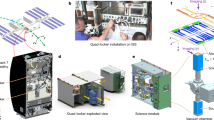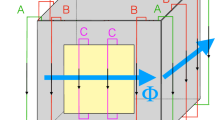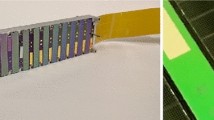Abstract
The procedures for the production of a very low magnetic field of 10-11 tesla in a full scale prototype dewar have recently been completed. The GP-B Relativity Gyroscope Experiment will provide a controlled test of Einstein’s General Theory of Relativity by making observations of the precession of nearly perfect gyroscopes in Earth orbit. The gyroscopes consist of highly spherical and homogeneous fused silica rotors which are coated with a thin superconductor and operated at a temperature of 2 K. Readout of gyro precession is accomplished by measuring the orientation of the magnetic dipole moment (London moment) which is generated by the spinning superconductor and is aligned with the spin axis. The GP-B experiment requires an ambient field of ≤ 2 × 10-11 tesla (2 × 10-7 gauss) in order to minimize trapped flux in the rotors and thereby insure the proper operation of the SQUID-based gyroscope magnetic readout. The process to reach the required low field level is by iterative expansion of superconducting lead foil shields. The methods developed to effect the lead shield expansions and to accurately measure the low field are presented along with the final results.
Access this chapter
Tax calculation will be finalised at checkout
Purchases are for personal use only
Preview
Unable to display preview. Download preview PDF.
Similar content being viewed by others
References
L. I. Schiff, Proc. Nat. Acad. Sci. 46: 871 (1960); also Phys. Rev. Lett. 4: 215 (1960).
A recent summary of key GP-B technologies and the current state of their development can be found in D. Bardas, et al., in: “Proceedings of the Sixth Marcel Grossman Meeting on General Relativity,” H. Sato and T. Nakamura, ed., World Scientific Press, Singapore (1992), p. 382.
A more detailed discussion of the GP-B gyro design and fabrication can be found in J. P. Turneaure, et al., Adv. Space Res. 9: 29 (1989) and references therein.
F. London, “Superfluids, Vol. 1: Macroscopic Theory of Superconductivity,” Dover, New York (1961).
J. M. Lockhart, Proc. SPIE 619: 148 (1986).
C. W. F. Everitt, D. E. Davidson, R. A. Van Patten, Proc. SPIE 619: 148 (1986).
The design and fabrication of the probe and dewar are the responsibility of Lockheed R, D&D, and the SIA development, including that of the telescope, gyros, and readout, is being done by Stanford University.
Vacuumschmelze GMBH, Hanau, Germany
B. Cabrera, Near zero magnetic fields with superconducting shields, in: “Near Zero: New Frontiers of Physics, ” J. D. Fairbank, et al., ed., W. H. Freeman, New York (1988) p. 312.
Details of the dewar and probe design are included in R. T. Parmley and G. M. Reynolds in: “Proceedings of the First William Fairbank Meeting on Relativistic Gravitation & Physics in Space”, World Scientific, Singapore (to be pub.).
M.A. Taber, et al., in: “Proceedings of the First William Fairbank Meeting on Relativistic Gravitation & Physics in Space”, World Scientific, Singapore (to be pub.)
A subset of the magnetic data that has been accumulated for use in designing apparatus intended for ultralow magnetic field environments can be found in J.M. Lockhart, R.L. Fagaly, L.W. Lombardo, and B. Muhlfelder, Physica B 165 & 166: 147 (1990).
B. Cabrera and F. van Kann, Acta Astronautica 5: 125 (1978).
The specification of 0.2% Sn in the lead foil keeps the surface of the foil largely oxide free. This allows the welds to be carried out without the use of a flux which would contaminate the shield and act as an adhesive between layers of foil.
Both the trapped field and the fringing field from the open top of the shield should be transverse. The former because the shield expansion is transverse in direction, and the latter because the external axial field has a shorter decay length than the tranverse component. See B. Cabrera, Ph.D Thesis, Stanford University (1974).
Author information
Authors and Affiliations
Editor information
Editors and Affiliations
Rights and permissions
Copyright information
© 1994 Springer Science+Business Media New York
About this chapter
Cite this chapter
Taber, M.A., Murray, D.O., Lockhart, J.M., Frank, D.J., Donegan, D. (1994). Production of Ultralow Magnetic Fields for Gravity Probe B (GP-B). In: Kittel, P. (eds) Advances in Cryogenic Engineering. Advances in Cryogenic Engineering, vol 39. Springer, Boston, MA. https://doi.org/10.1007/978-1-4615-2522-6_19
Download citation
DOI: https://doi.org/10.1007/978-1-4615-2522-6_19
Publisher Name: Springer, Boston, MA
Print ISBN: 978-1-4613-6074-2
Online ISBN: 978-1-4615-2522-6
eBook Packages: Springer Book Archive




